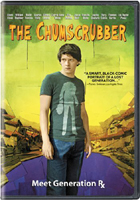 BUY IT AT AMAZON: CLICK HERE!
BUY IT AT AMAZON: CLICK HERE!
STUDIO: Dreamworks Home Entertainment
RATED: R
MSRP: $29.99
RUNNING TIME: 107 Minutes
SPECIAL FEATURES:
• Feature Commentary w/ Arie Posin and Zac Stanford
• "Making-Of" featurette
• 10 deleted/extended scenes
Here’s a film sorely hampered by reductionist marketing. The tagline, synopses, and promotional imagery all paint it as American Beauty brought down a couple of generations, or Prozac Nation as deliberate fiction. It is neither of these things. It’s an ensemble character drama with as tight a cohesion as Magnolia and a focus as clear-eyed and darkly humorous as a Mark Twain essay, though maybe one where ol’ Sam was hitting the sauce kinda hard — like, hallucinogenic hard.
I don’t envy the marketing team that had to come up with a way to sell this film to the public, but I hope their misapplied efforts don’t end up cheating it out of the audience it deserves.
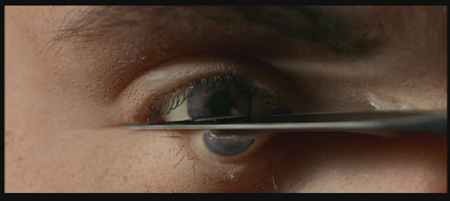
Un chien skaterpunk.
The Flick
The Chumscrubber played at Sundance in 2005 to a decent audience response, though nothing exuberant enough to set it up for a wide release. It’s the story of Dean Stiffle, played with nuance by Jamie Bell, who is still most well-known for his title role in Billy Elliot. Dean is a bit of an outsider at his school, and not really interested in friends. The only person he claims as his friend is
One morning, Dean goes to visit
The broad scenario, as described, isn’t what will attract you to this film; what will is the way each scene is written, and the way they challenge your expectations of how drama should unfold. Immediately after discovering
This is the stuff that humor is made of; it’s a dark humor, and is rarely overt — in fact, the few cheap laughs feel like distractions rather than welcome breathers from the morose subjects. It makes a certain sort of internal sense that a film obsessed with the meanings and methods of happiness would be so focused on eliciting sardonic chuckles from its audience.

Does Anything Red Exist?
Happiness really is the key to the movie. The suburban ideal of the pursuit of happiness is the reigning mindset throughout, and the symbols of happiness litter the script. Each character has a symbolic representation of happiness: pills, family, flowers, a decapitated superhero — but each has some sort of problem digging under the signifier, their personal gods, to the signified, the true quality of happiness. It’s like everyone in the film is wearing a sandwich board with some individual slogan and doesn’t understand the language the words are written in.
Director Arie Posin assembled a grand ensemble of questing housewives and husbands, featuring Glenn Close, William Fichtner, Ralph Fiennes, Jason Isaacs, Allison Janney, Rita Wilson, Carrie-Anne Moss, John Heard, Rory Culkin, Camilla Belle, and Justin Chatwin, among others. Listing relevant credits for each would just clutter up the paragraph, so I’m just going to trust that you’re suitably overwhelmed by the number of familiar names. Ensemble casts are historically hard to deal with, unless you’re Robert Altman, but Posin does a fine job thanks to a superb script which gives everyone — and I mean everyone — a distinct role to play both as a character and as a cog in the story’s structure. With all this talent on display, it’s amazing the film doesn’t feel like a Charlie Foxtrot.
I do want to pick on a couple of standout performances: that of Allison Janney as Dean’s mother, and that of Justin Chatwin, who plays the bully ringleader Billy. Chatwin’s job as Billy makes up for his lack of anything worthwhile as Tom Cruise’s son in last summer’s War of the Worlds remake. Billy is a punk, with a vulnerable side that only comes out in bravado. He doesn’t get weepy or sentimental: his bluster is completely honest, and it creates a clever subtext that the audience is pretty sure Billy doesn’t even know about. Billy’s last line, as a result, is simultaneously hilarious, stupid, and heartbreaking.
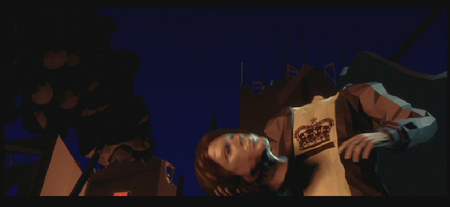
Test footage for Pixar’s next project: The Girl Who Wore A Green Ribbon.
Allison Janney, who plays Dean’s mother, gets what I think is just about the best role in the whole movie. She is one of the few adults that intrudes fully into the teenage world that occupies most of the running time. She is full of good intentions and smiles, and she teases the audience’s curiosity, making them wonder how much of her big old grin is veneer and how much of it goes deeper. She is the first character to explicitly recognize that she has confused the symbol for what it symbolizes, and her conversation with her son directly following is just plain sweet.
So, Posin created a machine built from a number of tiny gears, with plenty of points of failure; it’s a great credit to his skill, as well as the talents of his screenwriter, Zac Stanford, that there’s barely a grain of dust in the bearings. Scenes are set up with a firm line of plot progression, with numerous subtle references to previous scenes that creates an internal cohesion. Conflicts of situation are built upon, sequence after sequence, with rarely a false resolution or even a red herring. The dialogue is smart and sticks well away from cliché. All together, it’s a solid example of what happens when you have a filmmaker with an unclouded vision for what he wants to accomplish.
For all my praise, there is the caveat that this is a movie that will gather a predominantly teenage audience. I am a writer only recently out of my teens, and, while I trust my ability to critically examine a film, I also realize that I am a product of my generation as regards my choices in entertainment. The teenagers of The Chumscrubber get most of the good lines and the lion’s share of the character development, while the adults mostly occupy archetype space. If it is a movie aimed at teenagers, then it is an important one, because rather than being focused on the minutiae of angst, it is concerned with the motivating factors behind the pursuit of self-gratification, which is the true teenage dream.
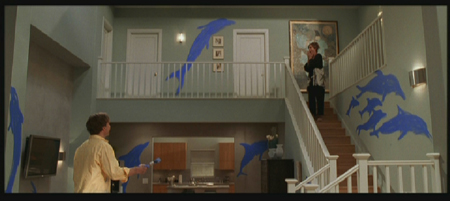
Can you say "porpoise" without laughing?
I believe it pushes beyond the college-guy cutoff in audience appeal, though, because it is a criticism of those things that absorb the adult mind, the distracting symbols and carrots that replace the real emotions and victories. The adults we are shown are mired in their problems because they didn’t learn enough about themselves as teenagers, and, as a result, they try and medicate the crap out of their children in order that no one will have to face the difficulty of overcoming a real obstacle. It’s the adults who break away from that mindset of avoidance, the ones who borrow mannerisms from their self-knowledge-hungry children, who end up with satisfying endings when the credits run.
The Chumscrubber is a highly accomplished film, both in the technical aspects and in the narrative. I can heartily recommend it to anyone who wants a little depth in their suburban social dramas, or to anyone that wants a little catharsis in their comedies.
(And this is all without even mentioning the film’s greatest symbol: the Chumscrubber himself, an enigma that’s well worth puzzling over.)
8.7 out of 10
The Look
The presentation is 2.40:1 widescreen. The cinematography is the only aspect of this film that I feel was a bit lackluster. A lot of shots are framed in the static fashion used so often in American Beauty and even in Edward Scissorhands; they are shots designed to emphasize how much of a cookie-cutter culture suburbanites live in. Despite the workmanlike quality, there is a deliberation in the framing that brings out some delicious visual ironies.
The transfer is clean, but possibly errs on the side of brightness. A number of the bold colors seem inconsistent from shot to shot, especially during some of the daytime exteriors.
6.5 out of 10
The Noise
You have your choice between a Dolby 2.0 track and a Dolby 5.1 track. The sound design contributes a lot to anchoring the often abstracted scenarios in a solid, physical suburbia. The soundtrack is littered with indie-rock junk, which don’t contribute much to the overall feel of the scenes in which they appear; in between the songs, though, there is some fine and delicate piano work/jagged guitar noisepunk.
7 out of 10

Hooray! No spine jacks!
The Goodies
The disc has the small hand of basics: feature commentary, "making-of" featurette, and deleted/extended scenes. The gem is the commentary, with both director Arie Posin and writer Zac Stanford. The two share an easy dialogue and have the types of minds that trap all sorts of trivia. It’s the sort of commentary that has more in common with overhearing the conversation of a couple good friends than it does with listening to a lecture.
The behind-the-scenes documentary digs a little deeper than the normal marketing gee-whizzery, and, though brief, touches on a couple of the businesslike aspects of bringing a feature film into production. It veers into actors explaining their characters, and producers lauding their own choices, but it’s decently above average.
There are also ten deleted/extended scenes, that occupy the same "curiosity" space as most other cut footage packaged up on DVDs; nothing vital was excised.
7 out of 10
The Artwork
It doesn’t really give off any of the feel of the movie. I’m curious where the post-it note motif came from. It doesn’t look bad, but the angsty Bell trying to avoid making eye contact with the tagline just looks mundane. The logo of the Chumscrubber, the dude holding his own head, is pretty damn cool, and I can’t help but wondering if the customer curiosity over just that one image would have been enough.
6 out of 10
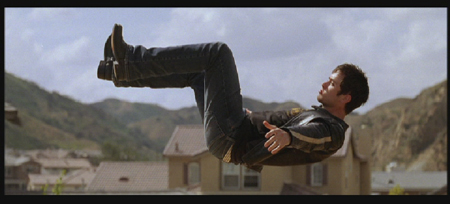
Let’s go for a ride, you and me, in my invisible spider-car.
Overall: 8.5 out of 10